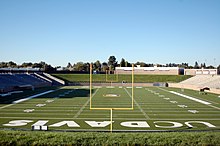University of California, Davis
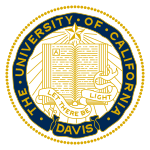 | |
Former names | University Farm (1905–1922) Northern Branch of the College of Agriculture (1922–1938) College of Agriculture at Davis (1938-1959) |
|---|---|
| Motto | Fiat lux (Latin) |
Motto in English | Let there be light |
| Type | Public land-grant research university |
| Established | 1905 (1959 as a general UC campus) |
Parent institution | University of California |
Academic affiliations |
|
| Endowment | $2 billion (2021)[1] |
| Budget | $4.9 billion (2017–18)[2] |
| Chancellor | Gary May[3] |
| Provost | Mary Croughan[4] |
Academic staff | 2,133 (Fall 2017)[5] |
Administrative staff | 21,486 (2014–15)[6] |
| Students | 40,031 (Fall headcounts 2020-21)[7] |
| Undergraduates | 31,162 (Fall 2020)[7] |
| Postgraduates | 8,869 (Fall 2020)[7] |
| Location | Unincorporated Yolo and Solano counties adjacent to Davis , California , United States 38°32′24″N 121°45′0″W / 38.54000°N 121.75000°WCoordinates: 38°32′24″N 121°45′0″W / 38.54000°N 121.75000°W |
| Campus | College town, 7,331 acres (2,967 ha)[8] |
| Academic term | Quarter |
| Colors | Aggie blue & gold[9] |
| Nickname | Aggies |
Sporting affiliations | NCAA Division I FCS – Big Sky (football) Big West (other sports) American East (hockey) |
| Mascot | Gunrock the Mustang |
| Website | ucdavis |
The University of California, Davis (UC Davis, UCD, or Davis) is a public land-grant research university near Davis, California.[10] Named a Public Ivy,[11] it is the northernmost of the ten campuses of the University of California system. The institution was first founded as an agricultural branch of the system in 1905 and became the seventh campus of the University of California in 1959.
The university is classified among "R1: Doctoral Universities – Very high research activity".[12] The UC Davis faculty includes 23 members of the National Academy of Sciences, 30 members of the American Academy of Arts and Sciences, 17 members of the American Law Institute, 14 members of the Institute of Medicine, and 14 members of the National Academy of Engineering.[13] Among other honors that university faculty, alumni, and researchers have won are two Nobel Prizes, a Presidential Medal of Freedom, three Pulitzer Prizes, three MacArthur Fellowships, and a National Medal of Science.[13][14][15][16]
Founded as a primarily agricultural campus, the university has expanded over the past century to include graduate and professional programs in medicine (which includes the UC Davis Medical Center), law, veterinary medicine, education, nursing, and business management, in addition to 90 research programs offered by UC Davis Graduate Studies. The UC Davis School of Veterinary Medicine is the largest veterinary school in the United States and has been ranked first in the world for five consecutive years (2015–19).[17] UC Davis also offers certificates and courses, including online classes, for adults and non-traditional learners through its Division of Continuing and Professional Education.[18]
The UC Davis Aggies athletic teams compete in NCAA Division I, primarily as members of the Big West Conference with additional sports in the Big Sky Conference (football only) and the Mountain Pacific Sports Federation.
Founding[]
Agriculture and the land-grant university[]
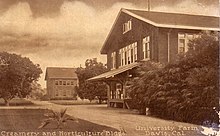
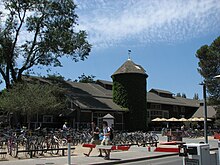
In 1868, the University of California was established as a land-grant university, and immediately founded a College of Agriculture as its first college as required by the Morrill Land-Grant Acts and the university's own Organic Act.[19][20] UC operated a small farm at the Berkeley campus for several years after Ezra S. Carr became professor of agriculture, but he managed to alienate both the university faculty and the state's farmers with his attempt to directly integrate practical training in farming with courses on the larger historical, social, and political dimensions of farming and got himself fired in 1874.[21] The faculty could not understand why students should earn credit towards degrees for hoeing or plowing, and the farmers could not understand how learning the social history of farming could make their children into better farmers.[21]
Eugene W. Hilgard, Carr's successor, recognized that Berkeley's soil and climate were terrible for farming (the campus directly faces the notoriously foggy Golden Gate) and switched from "practical" to what he called "rational" instruction in scientific principles of agriculture at Berkeley.[22] He concentrated on things like soil science and fermentation that could be researched and taught in a university laboratory, supplemented by limited data gathering and experiments (but not hands-on teaching) at agricultural experimental stations in the field.[23] Hilgard was disdainful of the idea of a university farm.[24] He felt that for such a farm to teach effectively, it would necessarily have to be a model farm with examples of the best of everything, without any reference to local profitability, climate, or circumstances, and such a thing was clearly infeasible.[24]
Founding of the University Farm[]
Around the turn of the 20th century, Peter J. Shields, secretary of the California Agricultural Society, became aware that colleges of agriculture elsewhere had university farms which performed experiments and provided hands-on education in useful agricultural subjects, and that young people were leaving the state to study at such farms.[25] Shields began to champion the cause of a university farm. He was later honored as the "founder" of UC Davis in 1962, when the Shields Oak Grove on campus was named after him, and again posthumously in 1972 when the campus library was named after him.[26] However, local farmer and politician George Washington Pierce Jr. also fought hard in the California State Assembly for the creation of a university farm, and influenced the drafting of the site criteria in the University Farm Bill to ensure that Yolo County would become the selected site—but unlike Shields, did not live long enough to see the promotion of Davis to a general campus and is now largely forgotten.[26]
On March 18, 1905, the University Farm Bill was enacted, which called for the establishment of a farm for the University of California.[27] A committee appointed by the Board of Regents took a year to select a site for the University Farm, a 779-acre farm near a tiny Yolo County town then known as Davisville.[28][27] The Regents officially took control of the property in September 1906 and constructed four buildings in 1907.
Short courses were first offered in October and November 1908, and then the University Farm officially opened in 1909 as the University Farm School, offering a three-year non-degree vocational program.[28] The vocational program was shortened from three to two years in 1923.[29]
Initially, no degrees were awarded at Davis.[30] Students in the College of Agriculture at Berkeley often enrolled at Davis for a single semester to obtain practical training on an actual farm alongside the vocational students, but had to return to Berkeley to earn their degrees.[30] Because the non-degree vocational program at Davis was so disconnected from the traditional degree programs on the main Berkeley campus, agricultural interests began to agitate to separate Davis and the entire College of Agriculture from the University of California.[30] This forced the Board of Regents in 1922 to silence such proposals by authorizing a four-year undergraduate degree program at Davis.[30] The first class graduated from Davis in 1926.[29]
Renamed in 1922 as the Northern Branch of the College of Agriculture, and, in 1938, as the College of Agriculture at Davis, the institution continued growing at a breakneck pace: in 1916 the Farm's 314 students occupied the original 778 acres (315 ha) campus. By 1951 it had expanded to a size of 3,000 acres (1,200 ha).[31] In 1958, the vocational program was discontinued.
Seventh UC campus[]
In 1959, the campus was designated by the Regents of the University of California as the seventh general campus in the University of California system.
Davis's Graduate Division was established in 1961, followed by the creation of the College of Engineering in 1962. The law school opened for classes in fall 1966, and the School of Medicine began instruction in fall 1968. In a period of increasing activism, a Native American studies program was started in 1969, one of the first at a major university; it was later developed into a full department within the university.
Notable events[]
2011 pepper spray incident and aftermath[]
During a protest against tuition hikes on November 18, 2011, a campus police officer, Lieutenant John Pike, used pepper spray on a group of seated demonstrators when they refused to disperse, and another officer also pepper sprayed demonstrators at Pike's direction. The incident drew international attention and led to further demonstrations, a formal investigation, and Pike's departure in July 2012.[32][33][34]
Documents released in 2016 through a public records request showed that the university had spent at least $175,000 to attempt to "scrub the Internet of negative postings" about the incident, in efforts that started in 2013.[35] California newspaper The Sacramento Bee obtained a document outlining the public relations strategy, which stated: "Nevins and Associates is prepared to create and execute an online branding campaign designed to clean up the negative attention the University of California, Davis, and Chancellor Katehi have received related to the events that transpired in November 2011". The strategy included an "aggressive and comprehensive online campaign to eliminate the negative search results" intended to achieve the "eradication of references to the pepper spray incident in search results on Google for the university and the Chancellor".[36] The university's strategic communications office, which has worked on the management of the reputation of the university and its chancellor, has had its budget substantially increased since the current chancellor took office – rising from $2.93 million in 2009 to $5.47 million in 2015. In August 2016 Katehi resigned as chancellor, and under the terms of her contract, will continue to be a full-time faculty member at UCD.[37]
Campus[]

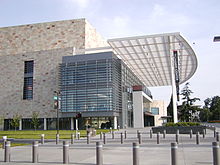
Size and location[]
Although named after the City of Davis, the campus is technically located adjacent to the City of Davis in an unincorporated part of Yolo and Solano counties. The main campus is located 15 miles (24.1 km) west of Sacramento in the Sacramento Valley, part of California's Central Valley, and is adjacent to Interstate 80.
The city of Davis is a college town, with the ratio of students to long-term residents estimated at 1:4. Also contributing to the college-town environment is the close proximity of downtown Davis to the campus' main quad—a matter of a few blocks, and 5- to 10-minute walk or bike ride. Davis' 15-minute distance from Sacramento provides it with both the isolation critical to fostering a college-town environment while also providing a lively and large metropolitan area nearby. Although the campus itself is vast, the entire community of Davis is relatively small and is easily traversable on bike utilizing Davis' extensive bicycle trails.[citation needed]
Campus Core/Quad[]
Towards the northeast end of campus is the Quad, a large rectangular field, which was the historic geographic center of campus. Earlier in the campus' history, the few campus buildings surrounded the four sides of the Quad. Today, though the campus has grown significantly and the geographic center of campus has shifted, the Quad remains the center of campus life, anchored to the north by the Memorial Union (student union), to the south by Shields Library and to the west and southeast by Wellman and Olson halls respectively. The Memorial Union Complex houses Freeborn Hall and the Memorial Union, which houses various establishments such as the UC Davis Bookstore.
The northeast side of campus holds more of the core buildings that were built earlier in UC Davis's history, such as Wellman Hall, Shields Library, Mrak Hall, and Hutchison Hall. Also notable in this northeastern corner is the labyrinthine Social Sciences and Humanities building designed by Antoine Predock, known to students as the "Death Star" for its angular, metallic design.[38]
South Main Campus and South Campus[]
The majority of Equestrian Center, and Animal Sciences buildings are located near the Arboretum Waterway, away from the core campus; the West Entry Parking Complex, the Silo Union, and the newly constructed Science Lecture Hall and the Science Laboratory Building are located nearer to the Tercero residence halls and the core of campus. The Mondavi Center, home of the University Symphony Orchestra and other cultural events, is also located near the Tercero complex.[39][40]
West Campus[]
For most of UC Davis' history, West Campus has served primarily as agricultural research land. Recently, portions were developed through a $300 million public-private partnership to form the largest zero net energy community in the United States, known as UC Davis West Village.[41] West Village will provide housing for 3,000 students, faculty and staff and will help the university recruit and retain top faculty. The project will include 662 apartments, 343 single-family homes, 42,500 square feet of commercial space, a recreation center and study facilities. West Village will also host the first community college on a UC campus.
The classes held in this area mainly involve plant sciences, but also include entomology courses as well. Students in the plant sciences maintain gardens as part of the PLS 5 lab while Entomology 156L and 158 students embark on field trips to sample fish for parasites at Putah Creek and conduct projects in forensic entomology at the UC Davis ecosystem, respectively. West Campus is also home to the University Airport, Foundation Plant Services, the California National Primate Research Center, and the Contained Research Facility, a bio-safety level 3 facility.[citation needed]
Arboretum[]
To the south side of the campus core is the 100-acre UC Davis Arboretum, which includes 3.5 miles of paved paths, 4,000 tree specimens, Putah Creek and Lake Spafford.[42] On March 10, 2017, a multi-year waterway enhancement project began.[43]
Artwork[]
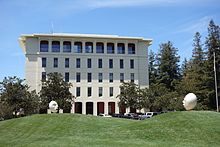
There are seven public art statues found around campus, collectively called The Egghead Series, sculpted by the late Robert Arneson, who also taught at Davis from 1962 to 1991.[44]
Bookhead is located at the Shields Library plaza, Yin & Yang is located at the Fine Arts Complex, See No Evil/Hear No Evil is at the east lawn of King Hall (the main building for UC Davis' School of Law), Eye on Mrak (FatalLaff) is outside Mrak Hall (housing the registrar office and other administrative offices), and Stargazer is located between North Hall and Young Hall. The Yin & Yang egg heads have been recast and duplicated for installation near the Port of San Francisco Ferry Building in San Francisco.[45]
Student housing[]
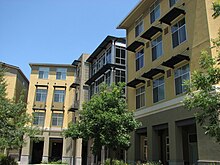
UC Davis Student Housing operates 23 residence halls totaling 29 buildings which are organized into three areas: Segundo, Tercero, and Cuarto.[46] UC Davis Student Housing is large enough to accommodate over 11,000 Students. Typically, campus operated housing is reserved exclusively for first-year students, whereby other students are required to seek housing off-campus at apartments or rented homes. The northwest end of campus holds the majority of the Segundo undergraduate housing complex, and various alternative housing sites, such as Orchard Park, Russell Park, The Colleges at LaRue Apartments, and Primero Grove. The Activities and Recreation Center, or the ARC, is also located near the Segundo complex. Adjacent to the northwest corner of campus is the Cuarto undergraduate housing complex, which has one dining commons.
The Tercero undergraduate housing complex is located near the geographic center of the UC Davis campus, to the north of the Arboretum Waterway. This extends longitudinally through almost the entirety of the south end of campus. Solano Park, UC Davis' family housing complex, is located adjacent to the Arboretum Waterway, at the Eastern end of campus. The Davis Arboretum is a public botanic garden with over 4,000 kinds of trees and plants, including many California native plants, which has been developed over 100 acres (40 ha) along The Waterway. The Cuarto undergraduate (freshmen and transfer students) housing complex is located one block off-campus, across Russell Boulevard. Unlike the other undergraduate housing complexes, Cuarto is located within city limits; its residents may vote in city elections.[citation needed]
Organization and administration[]
| Ethnic enrollment, Fall 2018[47] |
Under- graduates |
|---|---|
| African American | 4% |
| Native American | 1% |
| Asian American and Pacific Islander |
32% |
| Hispanic and Latino American |
22% |
| White | 23% |
| International | 17% |
| Other | 2% |
The entire University of California system is governed by the regents, a 26-member board, as established under Article IX, Section 9 of the California Constitution.[48] The board appoints the university's principal officers including the system-wide president and UC Davis Chancellor.
The UC Davis Chancellor has overall responsibility for the leadership, management, and administration of the campus and reports to the President of the University of California system, a position currently held by former Secretary of Homeland Security and Arizona Governor Janet Napolitano.
The Offices of the Chancellor and Provost is headed by the executive vice-chancellor and provost (EVCP). In their capacity as executive vice-chancellor, the EVCP shares with the chancellor in the overall leadership and management of campus administration and operations, whereas as provost, the EVCP is UC Davis' chief academic officer.
The senior staff provides executive support to the Offices of the Chancellor and Provost. The Council of Deans and Vice-Chancellor consists of the heads of the university's major academic and administrative units.[49]
Students are most likely to interact with or be directly affected by the Office of Student Affairs, which is run by the vice chancellor of student affairs, currently Fred Wood, and by a variety of associate and assistant vice-chancellors. This office oversees many campus units including: Admissions, Athletics, Campus Recreation, Campus Unions, Counseling and Psychological Services, Financial Aid, Student Housing and others.[50]
Student demographics[]
| Ethnicity | 2020 Undergraduate | 2016 Undergraduate | 2020 Graduate | 2016 Graduate |
|---|---|---|---|---|
| Black | 3.7% | 3.4% | 4.3% | 3.0% |
| Asian | 32.5% | 34% | 18.2% | 16.5% |
| White | 21.6% | 26.2% | 37.1% | 42.8% |
| Hispanic and Latino | 23.1% | 19.8% | 11.8% | 9.3% |
| Native American | 0.4% | 0.7% | 1.0% | 1.1% |
| Unreported/unknown | 2.2% | 2.5% | 5.6% | 5.2% |
| International | 16.4% | 13.3% | 21.9% | 22.1% |
Women comprised 60.4% of undergraduates in Fall 2018.[47]
In 2010, the United States Census Bureau made UC Davis its own separate census-designated place for statistical purposes.[52] The campus location is out of the bounds of the Davis city limit.
In 2014, Chancellor Katehi stated that UC Davis aims to become a Hispanic-Serving Institution by the 2018–2019 school year, with at least 25% of the undergraduate student body consisting of Latinos.[53]
Academics[]
The university has 102 undergraduate majors and 101 graduate programs.[54] It has a Department of Viticulture and Enology (concerning the scientific study of grape-growing and winemaking) that has been and continues to be responsible for significant advancements in winemaking utilized by many Californian wineries. The campus claims to be noted for its top-rated Agricultural and Resource Economics programs[55] and the large Department of Animal Science through which students can study at the university's own on-campus dairy, meat-processing plant, equestrian facility, and experimental farm. Students of Environmental Horticulture and other botanical sciences have many acres of campus farmland and the University of California, Davis, Arboretum at their disposal. The Department of Applied Science was founded and formerly chaired by physicist Edward Teller. The arts are also studied extensively on campus with subjects such as studio art, design, music, theater and dance. The Design Department at UC Davis is the only comprehensive academic design unit of the University of California system.[56] There is also the Mondavi Center for the Performing Arts which features artists from all over the globe.
UC Davis undergraduate majors are divided into four colleges:
- UC Davis College of Agricultural and Environmental Sciences
- UC Davis College of Biological Sciences
- UC Davis College of Engineering
- UC Davis College of Letters and Science
Rankings[]
|
|
| ||||||||||||||||||||||||||
UC Davis is considered to be a "Public Ivy."[11] In its 2021 edition, U.S. News & World Report ranked UC Davis tied for the 11th-best public university in the United States, tied for 39th nationally and tied for 66th globally.[65] Washington Monthly ranked UC Davis 13th in its 2020 National University ranking, based on its contribution to the public good as measured by social mobility, research, and promoting public service.[66] Money magazine ranked UC Davis 10th in the country out of 739 schools evaluated for its 2020 "Best Colleges for Your Money" edition[67] and 4th in its list of the 50 best public schools in the U.S.[68] Forbes in 2019 ranked UC Davis 88th overall out of 650 colleges and universities in the U.S., 49th among research universities, 22nd among public university, and 11th for "Best Value".[69] For 2018 Kiplinger ranked Davis 47th out of the top 100 best-value public colleges and universities in the U.S.[70]
The university has several distinguished graduate programs ranked in the top 10 in their fields by the United States National Research Council; most notable are its programs in agricultural economics, entomology, evolutionary biology, plant biology, and ecology. Additionally, the NRC placed more than a third of UC Davis graduate programs in the top 25% of their respective fields.[71] In 2016, U.S. News & World Report rated UC Davis 2nd globally in Agricultural Sciences, 1st in Plant and Animal Science, 4th in Environment/Ecology, and 1st nationally in Veterinary Medicine, 3rd in Ecology and Evolutionary Biology, 7th (tie) in Biological and Agricultural Engineering, 9th in U.S. Colonial History, 15th in Comparative Politics, 19th in Biological Sciences, 20th in Earth Sciences and 21st in Psychology.[65] The Economics department of UC Davis was also ranked 6th among public universities and 20th nationally according to the RePec (Research Papers in Economics) Rankings in 2011.[72] In 2013, The Economist placed UC Davis Graduate School of Management in the top 8% accredited MBA programs in the United States (ranked 37th nationally and 65th globally).[73]
The Academic Ranking of World Universities placed UC Davis 40th nationally and 90th globally for 2019.[74] In its 2019 rankings, Times Higher Education World University Rankings ranked it tied for 59th in the world.[75] The QS World University Rankings ranked it tied for 104th globally for its 2020 ratings, with Veterinary Science ranked 2nd in the world.[76]
In 2016, Sierra Magazine ranked UC Davis 8th in its "Coolest Schools" in America list for campus sustainability and climate change efforts.[77]
Admissions[]
| 2018 | 2017 | 2016 | 2015 | 2014 | |
|---|---|---|---|---|---|
| Applicants | 76,647 | 70,214 | 67,472 | 64,510 | 60,506 |
| Admits | 31,564 | 30,573 | 28,617 | 24,614 | 24,541 |
| % Admitted | 41.2 | 43.5 | 42.4 | 38.2 | 40.6 |
| Enrolled | 6,389 | 5,820 | 5,760 | 5,369 | 5,377 |
| Average GPA | 4.03 | 3.99 | 3.99 | 4.00 | 4.00 |
| SAT Range | 1150-1410* | 1120-1360* | 1570–1980 | 1600–2000 | 1620–2010 |
| ACT Range | 25-31 | 25-31 | 24–30 | 24–30 | 22–28 |
| *out of 1600 |
Admission to UC Davis is rated as "more selective" by U.S. News & World Report.[85]
For Fall 2019, UC Davis received 78,093 freshmen applications; 30,358 were admitted (39.1%) and 5,957 enrolled.[84] The average high school grade point average (GPA) of the enrolled freshmen was 4.13; the average SAT scores were between 610 and 710 for reading and 630-790 for math, and 28-34 for the ACT Composite score.[84]
Library[]
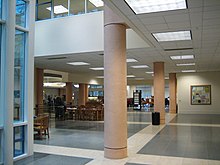
UC Davis' libraries include the Peter J. Shields Library, the Physical Sciences & Engineering Library, the Carlson Health Sciences Library, and the Medical Center Library in Sacramento, contain more than 3.5 million volumes and offers a number of special collections and services. The Peter J. Shields Library has three different architectural styles due to various construction and extensions being added; it is the main library where students study on-campus, with a 24-hour reading room, open computer labs, and unique furniture.
Army R.O.T.C.[]
The university is host to an Army Reserve Officer Training Corps (ROTC) program, the Forged Gold Battalion, with more than 50 cadets. With more than 60 years in existence, it currently commissions roughly 10 graduating seniors as second lieutenants every year.[86]
Graduate Studies[]
The University of California Davis Graduate Programs of Study consist of over 90 post-graduate programs, offering masters and doctoral degrees and post-doctoral courses.[87] The programs educate over 4,000 students[88] from around the world.
UC Davis has the following graduate and professional schools, the most in the entire UC system:
- UC Davis Graduate Studies
- Graduate School of Management
- School of Education
- School of Law
- School of Medicine
- School of Veterinary Medicine
- Betty Irene Moore School of Nursing
History[]
The University of California, Davis graduate division[89] has a long history. Graduate education has been a major feature of the academic focus for over 80 years. This academic tradition began in the fall of 1925, when 12 students received graduate degrees from the College of Agriculture through a partnership with the graduate division of the University California at Berkeley.[90][91] Over the years, the programs continued to grow, interact and collaborate. The first graduate degrees were awarded from the UC Davis campus in the fall of 1949.[92]
In 1961, autonomous Graduate Divisions and Graduate Councils were established on all University of California campuses to provide focused oversight of their graduate programs.[91]
Academics[]
A key feature of graduate education at UC Davis is the graduate group. The core elements of a graduate group include an emphasis on "shared research interests among faculty and students; flexibility to grow and quickly change to reflect emerging areas of interdisciplinary knowledge and technology; and an acceptance that many research questions transcend traditional academic departmental boundaries."[93] UC Davis offers more graduate groups than any other campus in the UC system.[94]
Medical school admissions[]
In 2016, U.S. News & World Report named UC Davis School of Medicine as the 6th most competitive medical school in the United States with an acceptance rate of 2.8%.[95]
Faculty and research[]
UC Davis is one of 62 members in the Association of American Universities, an organization of leading research universities devoted to maintaining a strong system of academic research and education. It consists of sixty universities in the United States (both public and private) and two universities in Canada.
Research expenditures[]
UC Davis spent $788.8 million on research and development in fiscal year 2018, ranking it 30th in the nation.[96]
Faculty honors[]
Its faculty includes 23 members of the National Academy of Sciences, 14 members of the National Academy of Engineering, 30 members of the American Academy of Arts and Sciences, 17 members of the American Law Institute, 5 members of the Royal Society, 3 Pulitzer Prize winners, 1 Guggenheim Fellow, and 3 MacArthur Fellows.[13]
Research centers and laboratories[]
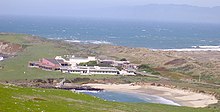
The campus supports a number of research centers and laboratories including:
- Advanced Highway Maintenance Construction Technology Research Laboratory
- BGI at UC Davis Joint Genome Center (in planning process)[97]
- Bodega Marine Reserve
- C-STEM Center
- CalEPR Center
- California Animal Health and Food Safety Laboratory System
- California International Law Center
- California National Primate Research Center
- California Raptor Center
- Center for Health and the Environment
- Center for Mind and Brain
- Center for Regional Change
- Center for the Study of Human Rights in the Americas
- Center for Visual Sciences
- Contained Research Facility
- Crocker Nuclear Laboratory
- Davis Millimeter Wave Research Center (A joint effort of Agilent Technologies Inc. and UC Davis) (in planning process)
- Information Center for the Environment
- John Muir Institute of the Environment (the largest research unit at UC Davis, spanning all Colleges and Professional Schools)
- McLaughlin Natural Reserve
- MIND Institute
- Plug-in Hybrid Electric Vehicle Research Center
- Quail Ridge Reserve
- Stebbins Cold Canyon Reserve
- (TERC) (a collaborative effort with Sierra Nevada University)
- UC Center Sacramento
- UC Davis Nuclear Magnetic Resonance Facility
- University of California Pavement Research Center
- University of California Solar Energy Center (UC Solar)
- Energy Efficiency Center (the very first university run energy efficiency center in the Nation).
- Western Institute for Food Safety and Security
The Crocker Nuclear Laboratory on campus has had a nuclear accelerator since 1966.[98][99] The laboratory is used by scientists and engineers from private industry, universities and government to research topics including nuclear physics, applied solid state physics, radiation effects, air quality, planetary geology and cosmogenics.[100] UC Davis is the only UC campus, besides Berkeley, that has a nuclear laboratory.
Agilent Technologies will also work with the university in establishing a Davis Millimeter Wave Research Center to conduct research into millimeter wave and THz systems.[101]
Student life[]
The undergraduate student government of UC Davis is the Associated Students of UC Davis (ASUCD), and has an annual operating budget of $11.1 million, making it one of the largest-funded student governments in the United States.[102] ASUCD includes an Executive, Legislative, and Judicial branch. Other than representing the student body on campus, the task of ASUCD is to lobby student interests to local and state government. Also under the purview of ASUCD are the student-run Coffee House, an ASUCD unit, and Unitrans, the Davis public bus system. ASUCD employs thousands of students[103] annually across its many units.
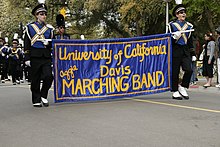
Picnic Day, UC Davis's annual Open House, is the largest student-run event in the United States. It attracts thousands of visitors each year with its many attractions. These include a parade, a magic show performed by the chemistry department, the Doxie Derby (dachshund races), film screenings, and a Battle of the Bands between the and other college bands including the Cal Band, the Stanford Band, and the Humboldt State University Marching Lumberjacks.
Another highlight of UC Davis is its student-run freeform radio station, KDVS. The station began operations on February 1, 1964, from the laundry room of the all-male dormitory Beckett Hall. The station soon gained a reputation by airing interviews with Angela Davis and a live call-in show with then California Governor Ronald Reagan in 1969. The station can now be heard on 90.3 FM and online at its website.[105]
UC Davis has over 500 registered student organizations, ranging from political clubs to professional societies to language clubs.
The academic Graduate Students and management students are represented by the Graduate Student Association (GSA). The Law Students are represented by Law Students Association.
Students are also encouraged to wear Aggie Blue on game days to show their Aggie Pride. If spotted wearing Aggie Blue by the Aggie Pack, students may have UC Davis paraphernalia thrown at them as a reward.
Students also participate in intramural sports such as basketball, ultimate frisbee, soccer and many more. The ARC contains a basketball gym, work out room, ping pong tables, squash courts, rock climbing wall, and other studio rooms for group exercise.

Other student activities and campus jobs:
- Unitrans, the student run (and driven) bus system.
- The Coffee House, also known as the CoHo, is a student run restaurant serving 7000 customers daily.
- The Bike Barn, a bicycle shop that sells and rents bicycles and cycling equipment, also a full-service repair shop.
- KDVS, student radio.[106]
- The Entertainment Council,[107] responsible for bringing famous musicians to campus and organizing student events.[108]
Transportation[]

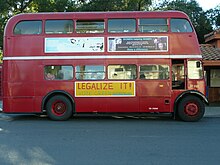
Bicyclists are ubiquitous on campus and in the city. Both the university and municipality encourages this with bicycle-only infrastructure such as bike circles, large bike lanes, and traffic signals specifically for bikes. UC Davis has a road and mountain bike team which has won several national championship titles.[109] The campus police department also has some of its officers patrol on bicycles and take bicycling under the influence ("BUI") and bicycling without a headlight at night very seriously. All bikes on the UC Davis campus must be registered with a California Bicycle license or they risk being sold at the on campus bike auction. Students usually have their bicycles serviced on-campus at the ASUCD Bike Barn or at other bike shops around town.
UC Davis is also well known for its bus service, Unitrans, and its trademark London double decker buses. It has been in operation since 1968 and is believed to be the only general purpose (non-sightseeing) transit system in the U.S. to operate vintage double deck buses in daily service. The system is operated and managed entirely by students and offers fixed-route transportation throughout the city. There is also an inter-campus bus service[110] that ferries back and forth between UC Davis and UC Berkeley twice daily, from Monday to Friday. Davis is also one of the busiest stations of the Capitol Corridor intercity railroad service operated by Amtrak between the Bay Area and Sacramento.
The central campus is bounded by freeways on two sides (Highway 113 and Interstate 80). All other UC campuses are either somewhat distant from the closest freeway or are directly adjacent to only one freeway. Two freeway exits are entirely within UCD's boundaries. One, off Highway 113, is signed "UC Davis / Hutchison Drive" and the other, off Interstate 80, is signed exclusively as "UC Davis." Despite the university's extensive bicycle infrastructure and public transportation service, easy freeway access coupled with increasing housing costs in the city of Davis has led to increased numbers of students commuting via automobile. Some students choose to live in the neighboring communities of Sacramento, Dixon or Woodland, and use their own cars or the county-wide Yolobus to get to UC Davis. In addition, a private charter bus that connected the Davis and Sacramento campuses was replaced in 2020 by the Causeway Connection bus service, in partnership with Yolobus and Sacramento Regional Transit.[111] Other students also commute by motorcycle, but are also subject to similar parking rates as their four-wheeled counterparts.
The California Aggie[]
UC Davis publishes a weekly student newspaper, The California Aggie. The Aggie was first published in 1915 as the Weekly Agricola after its approval by the Associated Student Executive Committee. At this point, UC Davis was considered the University Farm, an extension of UC Berkeley.[112]
Initially, the Weekly Agricola was focused on both student news and farming-related topics. Novelist Jack London was one of the first readers of the Weekly Agricola. In 1922, it was renamed to match the school's athletic name.[112] Between March 2014 and October 2016, the Aggie not in print but was still accessible online. The Aggie is in print and available on campus again as of October 2016.[113]
Greek life[]
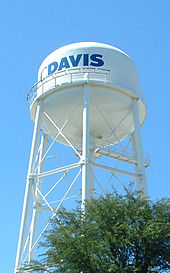
Social fraternities and sororities have been a part of the University of California at Davis since 1913. Approximately 8% of the university's undergraduate students are involved in the school's fraternities and sororities. One sorority, Sigma Alpha Epsilon Pi, was featured during the first season of the MTV reality show Sorority Life.
There are currently 21 social fraternities that are a part of the Interfraternity Council (IFC) in Davis. The IFC representatives attend weekly meetings to guarantee that all UC Davis rules and regulations are followed. The meetings are also used to inform the fraternities about all upcoming activities throughout the week. The 21 fraternities are: Alpha Epsilon Pi, Alpha Gamma Omega, Alpha Gamma Rho, Alpha Sigma Phi, Chi Phi, Delta Chi, Delta Lambda Phi, Delta Sigma Phi, Kappa Sigma, Phi Delta Theta, Phi Kappa Psi, Pi Kappa Alpha, Pi Kappa Phi, Sigma Alpha Mu, Sigma Chi, Sigma Nu, Sigma Phi Epsilon, Tau Kappa Epsilon, Theta Chi, Theta Xi, and Zeta Psi.[114]
The Davis Collegiate Panhellenic Council (DCPA) is similar to the Interfraternity Council, but is the governing council for several sororities at UC Davis. They are responsible for organizing recruitment, and overseeing that all regulations are upheld. There are currently 11 sororities that are a part of the Panhellenic Council. The 11 sororities are: alpha Kappa Delta Phi, Alpha Chi Omega, Alpha Delta Pi, Alpha Phi, Chi Omega, Delta Delta Delta, Delta Gamma, Kappa Alpha Theta, Kappa Kappa Gamma, Pi Beta Phi, Sigma Alpha Epsilon Pi.[115]
The Phi chapter of Alpha Gamma Rho was locally established May 1, 1923, at UC Davis, making it the first continuously running national fraternity on campus. They started as the Kappa Tau fraternity, which was the first Agricultural craternity on campus. Many campus buildings are named after alumni of Alpha Gamma Rho such as Emil Mrak (Mrak Hall, Registrar's office), Orville Thompson (Thompson Hall, Segundo student housing), and Dean De Carli (the De Carli room, 2nd floor MU), Mel Olson Scoreboard (Aggie Stadium), and many more. The AGR Hall is an event space located inside the Buehler Alumni / Visitor's Center and is commonly rented out as a conference room or banquet hall. There are both national and local fraternities and sororities at UCD with diverse backgrounds and histories.[116]
Athletics[]
The UC Davis Aggies (also referred to as Cal Aggies or Ags) compete in NCAA Division I sports league in the Big West Conference. For football, the Aggies compete in Division I FCS (formerly known as Division I-AA), and are members of the Big Sky Conference, granting UC Davis the distinction of being one of only three UC campuses to field a football team (Cal and UCLA being the other two). The Aggies are also members of the Mountain Pacific Sports Federation in gymnastics and lacrosse, the America East Conference in field hockey, the Western Intercollegiate Rowing Association and Davis Men's Crew Club for rowing.
The UC Davis Men's Crew Club is one of the successful clubs both on campus and in the West. In 2008 the JV boat won first in nationals at the ACRA Championships in Tennessee and in 2009 the Varsity boat got second place in nationals at the ACRA Championships. They consistently compete against teams such as Stanford, the University of Washington and UC Berkeley.
The Aggies finished first in NCAA Division II six times in 2003 and won the NACDA Directors' Cup 4 years in a row from 1999 to 2003. In 1998, the UC Davis men's basketball team won the NCAA Division II national championship despite being one of the few non-scholarship institutions in Division II at that time. They have also won NCAA Division II championships in Softball (2003), Men's Tennis (1992), and Women's Tennis (1990, 1993). These and other achievements motivated a decision (following a year of heavy discussion by campus administrators, faculty, staff, students, alumni and the local community) in 2003 for the athletics program to re-classify to Division I.[117][118]

The highlight of UC Davis's 4-year transition to Division I occurred on September 17, 2005, when the Aggies defeated the heavily favored Stanford Cardinal at Stanford Stadium by a score of 20–17 on a touchdown pass with 8 seconds left in the game. The Aggies also pulled off an upset against Stanford in basketball just months later, beating the Cardinal 64–58 with a late rally at home on December 4, 2005. The win in these two major sports and the addition of the Aggies beating the Cardinal in soccer earlier in 2005 as well as a win in wrestling and two wins in baseball pulled the Aggies' win loss record with Stanford to 5–1 for men's sports the 05-06 year.
The Aggie football team plays Sacramento State in the annual Causeway Classic for the Causeway Carriage. The team also plays Cal Poly San Luis Obispo in the annual Battle for the Golden Horseshoe. UC Davis students gather at sporting events to rally as the Aggie Pack, the largest student-run school spirit organization in the United States. The Aggie Pack cheers on the sports team along with the Spirit Squad to the music of the Cal Aggie Marching Band-uh! and its alumni band. Aggie Stadium is the home of the UC Davis football and lacrosse teams.
UC Davis had a wrestling program, which competed in the Pac-10 at the Division I level. In 2007, UC Davis wrestler Derek Moore gained All-American status, as well as winning the NCAA Division I Championships for his weight class. Moore also received the "Most Outstanding Wrestler" award of the NCAA tournament. In doing so, Derek Moore became the first UC Davis student-athlete to become an NCAA champion at the Division I level. That same year, UC Davis finished within the top 25 for Division I collegiate wrestling programs in the country.
Because of budget pressure, wrestling was cut from the athletic department in April 2010. Other cuts included men's swimming, men's indoor track, and women's rowing. The athletics department had to cut $1.79 million out of the budget. 14 women's teams and 9 men's teams were funded for the 2010–2011 school year.[119]
The official school colors are blue and gold. The blue is due to the UC's early connection to Yale[120] and as a result is often referred to as "Yale Blue" (e.g., see).[121] and[122] UCD's official blue, usually called "Aggie Blue", is Pantone 295,[123] which is distinct from Yale Blue (approximately Pantone 289).[124]
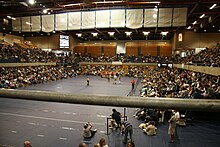
The official school mascot is the mustang. Students at UC Davis are referred to as Aggies in honor of the school's origins in agricultural studies. Unlike most colleges, there is a distinction between the name for students and the mascot. Some students supported changing the school mascot from the mustang to a cow, but alumni opposed this action. Many people call the mustang mascot of UC Davis an Aggie, but it is named Gunrock. The name dates to 1921 when the US Army brought a thoroughbred horse named Gunrock to UC Davis to supply high-quality breeding stock for the U.S. Cavalry remount program. The mustang mascot was selected to honor that cavalry horse.
Sustainability[]
UC Davis has implemented many environmentally sustainable features on campus. In the Fall of 2010, UCD opened a renovated Dining Commons in the Cuarto living area. The dining hall uses local produce and promotes sustainability. The university operates twenty LEED-certified buildings across three of the five overarching LEED categories.[125] Examples include the Robert Mondavi Institute for Wine and Food Science, the first brewery, winery or food-processing facility in the world to achieve Platinum-level certification and the at Lake Tahoe, one of only five laboratories in the world to achieve Platinum-level certification.[126] It developed UC Davis West Village as a "zero net energy" community.[127]
The university received two Best Practice Awards at the 2009 annual Sustainability Conference, held by the University of California, California State University and the California Community Colleges, for the campus's lighting retrofit project and sustainable design in new construction.[128]

UC Davis harvests olives from the old trees on campus to produce olive oil[129] and table olives for use in campus dining rooms.[130] It has designed landscaping with drought-tolerant trees and other plants.[131] The campus operates its own landfill, where it converts landfill (methane) gas to energy.[132] For its efforts in campus sustainability, UC Davis earned an A- on the 2011 College Sustainability Report Card, one of 27 universities to achieve this, the highest grade awarded.[133]
In February 2014, UC Davis and Diamond Developers formed a joint venture to create a sustainable city in Dubai, United Arab Emirates.[134] The draft design for the sustainable city in Dubai called for an “eco-village” on 120 acres with enough housing for 1,200 people. The plan called for K-12 education, apartments, single family homes, and retail shops.[135] In May 2015, UC Davis and Diamond expanded the joint venture to include sustainability professional training program.[134]
UC Davis became the first university to implement requiring payment of a fee for all single-use bags distributed on campus; it is working to become the first university campus to ban plastic bags entirely.[136]
UC Davis is also home to the Agricultural Sustainability Institute (ASI),[137] which is part of the College of Agricultural and Environmental Sciences (CAES). ASI provides leadership for research, teaching, outreach, and extension efforts in agricultural and food systems sustainability at the Davis campus and throughout the UC system.
UC Davis hosted the Governors' Global Climate Summit 3 (GGCS3),[138] an international climate forum for the top leaders of local, regional, national and international entities, as well as those from academia, business and nonprofits. The summit worked to broaden national partnerships in continuing to grow a clean, green economy. The summit included more than 1,500 attendees from more than 80 countries.
Alumni[]
UC Davis currently has over 260,000 living alumni.[139] Notable alumni of UC Davis include two astronauts; scientist Katherine Jungjohann; US Treasurer Anna Escobedo Cabral; Chevron CEO John S. Watson; entrepreneur Jason Lucash; and actor Matthew Moy. Charles Moen Rice (born August 25, 1952), an American virologist and was awarded the 2020 Nobel Prize in Physiology or Medicine "for the discovery of Hepatitis C virus." Notable faculty include two-time Pulitzer Prize-winning historian Alan Taylor and painter Wayne Thiebaud.
- Notable UC Davis alumni include:

Anna Escobedo Cabral, US Treasurer
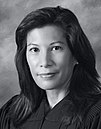
Tani Cantil-Sakauye, Chief Justice of California

Ann Veneman, former United States Secretary of Agriculture

DeAnne Julius, American-British economist

Sir Chow Chung-kong, chairman of Hong Kong Exchanges and Clearing

John S. Watson, CEO of Chevron
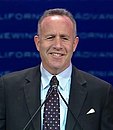
Darrell Steinberg, mayor of Sacramento
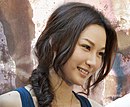
Kate Tsui, Hong Kong actress
Hasan Minhaj, actor and comedian

DJ Shadow, music producer and DJ

James F. Brooks, historian and professor

Doug Girod, chancellor of the University of Kansas
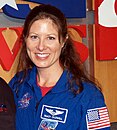
Tracy Caldwell Dyson, chemist and NASA astronaut
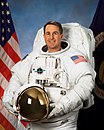
Stephen Robinson, NASA astronaut

Daniel Descalso, infielder for the Arizona Diamondbacks
Colton Schmidt, American football punter
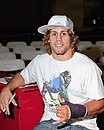
Urijah Faber, mixed martial artist

Martin Yan, cooking show host and food writer
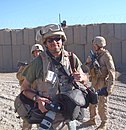
Ed Darack, Author and photographer
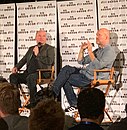
Christopher Markus and Stephen McFeely, screenwriters for various Marvel Studios films including Avengers: Infinity War and Avengers: Endgame
See also[]
- Mondavi Center
- The Pavilion (UC Davis)
- Manetti Shrem Museum of Art
References[]
- ^ As of July 30, 2021; includes UC Regents portion allocated to UC Davis. "Annual Endowment Report for the Fiscal Year Ended June 30, 2019" (PDF). University of California. Retrieved February 3, 2020.
- ^ "UC Davis 2017-18 annual budget" (PDF). UC Davis. April 16, 2018. Archived from the original (PDF) on April 28, 2018. Retrieved April 27, 2018.
- ^ "Why Gary May is a promising pick to lead UC Davis". Sacramento Bee. Retrieved February 25, 2017.
- ^ Blouin, Melissa (June 16, 2020). "UC Davis Chancellor Gary May Selects Mary Croughan as Next Provost and Executive Vice Chancellor". UC Davis (Press release). Retrieved November 25, 2020.
- ^ "UC Davis Student Profile" (PDF). University of California, Davis. Archived from the original (PDF) on December 3, 2015. Retrieved May 20, 2019.
- ^ "UC Davis Total On- and Off-Campus Headcount Population: Annual Averages" (PDF). UC Davis Institutional Analysis. November 16, 2015. Archived from the original (PDF) on December 19, 2014.
- ^ Jump up to: a b c "Student Population Summary". UC Davis. 2020. Retrieved August 21, 2021.
- ^ "University of California Annual Financial Report 18/19" (PDF). University of California. p. 8. Retrieved October 12, 2020.
- ^ "Colors – Marketing Toolbox". ucdavis.edu.
- ^ "Annual Financial Report, 12/13; p.10" (PDF). Executive Vice President, CFO of the Regents of the University of California.
- ^ Jump up to: a b Greene, Howard R.; Greene, Matthew W. (2001). The public ivies: America's flagship public universities (1st ed.). New York: Cliff Street Books. ISBN 978-0060934590.
- ^ "University of California, Davis". Classifications. Indiana University. 2020. Retrieved January 18, 2021.
- ^ Jump up to: a b c "National and International Honors". University of California, Davis. 2015. Archived from the original on December 22, 2015. Retrieved December 21, 2015.
- ^ "Alumnus Charles Rice Wins Nobel Prize for Medicine". UC Davis. October 5, 2020. Retrieved October 7, 2020.
- ^ "A Piece of the Nobel for UC Davis". University of California, Davis. 2007.
- ^ "1996: Beachell and Khush". World Food Prize. The World Food Prize Foundation. Retrieved January 31, 2020.[permanent dead link]
- ^ "US News Graduate School Rankings for Veterinary Medicine". U.S. News & World Report. 2019.
- ^ "UC Davis Continuing and Professional Education". cpe.ucdavis.edu. Archived from the original on December 13, 2019. Retrieved January 2, 2020.
- ^ Stadtman, Verne A. (1970). The University of California, 1868–1968. New York: McGraw-Hill. pp. 141–142.
- ^ See Cal. Stats., 17th sess., 1867–1868, ch. 244, § 2.
- ^ Jump up to: a b Stadtman, Verne A. (1970). The University of California, 1868–1968. New York: McGraw-Hill. pp. 143.
- ^ Stadtman, Verne A. (1970). The University of California, 1868–1968. New York: McGraw-Hill. pp. 144.
- ^ Stadtman, Verne A. (1970). The University of California, 1868–1968. New York: McGraw-Hill. pp. 145.
- ^ Jump up to: a b Stadtman, Verne A. (1970). The University of California, 1868–1968. New York: McGraw-Hill. pp. 150.
- ^ Stadtman, Verne A. (1970). The University of California, 1868–1968. New York: McGraw-Hill. pp. 151.
- ^ Jump up to: a b Rifkin, Rich (November 7, 2012). "Peter J. Shields: remembering a long life". Davis Enterprise. McNaughton Newspapers, Inc. p. A10. Retrieved August 21, 2020.
- ^ Jump up to: a b Dubgenans, Dennis (2013). University of California, Davis. Charleston: Arcadia. p. 7. ISBN 978-0-7385-9699-0.
- ^ Jump up to: a b Stadtman, Verne A. (1970). The University of California, 1868–1968. New York: McGraw-Hill. pp. 152.
- ^ Jump up to: a b "History of UC Davis". UC Davis Archives and Special Collections website. Retrieved November 8, 2020.
- ^ Jump up to: a b c d Stadtman, Verne A. (1970). The University of California, 1868–1968. New York: McGraw-Hill. pp. 340.
- ^ "History from UC Davis official site". November 19, 2015. Retrieved December 21, 2019.
- ^ Pringle, Paul; Quinones, Sam (November 20, 2011). "UC Davis chief launches probe into pepper-spraying of Occupy protesters". Los Angeles Times.
- ^ Gordon, Larry; Sewell, Abby (November 20, 2011). "UC president vows to review police procedures at campuses". Los Angeles Times.
- ^ "Pepper-spraying policeman departs U.C.-Davis". CNN. August 1, 2012.
- ^ Stanton, Sam; Lambert, Diana (April 13, 2016). "UC Davis spent thousands to scrub pepper spray references from Internet". Sacramento Bee. Retrieved April 13, 2016.
- ^ Rawlinson, Kevin (April 21, 2016). "Pepper spray university says sorry for search manipulation". BBC News Online. Retrieved April 21, 2016.
- ^ Chokshi, Niraj, "Embattled University of California, Davis, Chancellor Resigns", The New York Times, August 9, 2016.
- ^ "Trying to understand: Doomed in the "Death Star"". The Aggie. November 21, 2013. Retrieved November 28, 2019.
- ^ "ucdavis.edu". Archived from the original on September 5, 2017. Retrieved September 5, 2017.
- ^ Douglass, John; Thomas, Sally. "Atkinson Photographic Catalog - Davis Catalog". www.lib.berkeley.edu.
- ^ "Backgrounder — UC Davis West Village". Westvillage.ucdavis.edu. Archived from the original on December 8, 2011. Retrieved March 28, 2012.
- ^ Hetrick, Katie (November 16, 2018). "UC Davis Arboretum Visitor Map". UC Davis Arboretum and Public Garden. Retrieved June 21, 2020.
- ^ "Arboretum Waterway Maintenance and Enhancement Project". UC Davis Arboretum website. Retrieved October 4, 2017.
- ^ Levin, Elaine (1988). The History of American Ceramics: From Pipkins and Bean Pots to Contemporary Forms, 1607 to the present. Ny, Ny: Harry N. Abrams. pp. 227–230. ISBN 0-8109-1172-8.
- ^ "They're egg-cellent!". The California Aggie. Archived from the original on October 15, 2007. Retrieved July 14, 2007.
- ^ "Archived copy". Archived from the original on October 15, 2017. Retrieved October 14, 2017.CS1 maint: archived copy as title (link)
- ^ Jump up to: a b "Student Profile". UC Davis. November 26, 2015. Retrieved May 20, 2019.
- ^ "The Regents". University of California Site. Retrieved February 3, 2011.
- ^ "UC Davis Administration". UC Davis Site. Archived from the original on February 11, 2011. Retrieved February 3, 2011.
- ^ "UC Davis Student Affairs". UC Davis Site. Archived from the original on November 15, 2007. Retrieved February 3, 2011.
- ^ "Fall enrollment at a glance". University of California. May 23, 2021.
- ^ "University of California-Davis". Geographic Names Information System. United States Geological Survey.
- ^ Katehi, Linda (September 30, 2014). "Diversity Leads to Success in Higher Education". The Huffington Post. Retrieved January 27, 2015.
- ^ "Facts". University of California, Davis. November 19, 2015. Archived from the original on January 1, 2016. Retrieved September 29, 2019.
- ^ "UC Davis: Agricultural and Resource Economics". January 29, 2014. Archived from the original on October 23, 1996. Retrieved December 9, 2011.
- ^ "UC Davis: Majors – Design". November 30, 2015. Archived from the original on December 8, 2011. Retrieved December 9, 2011.
- ^ "Wall Street Journal/Times Higher Education College Rankings 2021". The Wall Street Journal/Times Higher Education. Retrieved October 20, 2020.
- ^ "2021 Best National University Rankings". U.S. News & World Report. Retrieved September 24, 2020.
- ^ "2020 National University Rankings". Washington Monthly. Retrieved August 31, 2020.
- ^ "Academic Ranking of World Universities 2020". Shanghai Ranking Consultancy. 2020. Retrieved August 15, 2020.
- ^ "World University Rankings 2021". Times Higher Education. Retrieved September 2, 2020.
- ^ "2021 Best Global Universities Rankings". U.S. News & World Report. Retrieved October 20, 2020.
- ^ "University of California—Davis – U.S. News Best Grad School Rankings". U.S. News & World Report. Retrieved October 20, 2020.
- ^ "University of California—Davis – U.S. News Best Global University Rankings". U.S. News & World Report. Retrieved October 20, 2020.
- ^ Jump up to: a b "U.S. News Best Colleges Rankings: UC-Davis". U.S. News & World Report. Retrieved October 20, 2020.
- ^ "2020 National University Rankings". Washington Monthly. Retrieved September 1, 2020.
- ^ "The Best Colleges in America, Ranked by Value". Money. August 25, 2020.
- ^ "Best Public Colleges". Money. August 25, 2020.
- ^ "America's Top Colleges 2019". Forbes. August 15, 2019.
- ^ "Kiplinger's Best Values in Public Colleges 2018". Kiplinger's Personal Finance. December 2017.
- ^ "UC Davis Office of Graduate Studies: A Data-Based Assessment of Research-Doctorate Programs in the United States" (PDF). University of California, Davis. 2010.
- ^ "Economics department ranked number 6 among public U.S. universities and ranked in the top 20 among public and private U.S. universities. — Economics at UCDavis". Econ.dss.ucdavis.edu. Archived from the original on December 5, 2014. Retrieved August 17, 2014.
- ^ "The Economist Ranks UC Davis MBA in the World's Top Tier – UC Davis Graduate School of Management". Gsm.ucdavis.edu. Archived from the original on August 19, 2014. Retrieved August 17, 2014.
- ^ "Academic Ranking of World Universities – 2019". ShanghaiRanking Consultancy.
- ^ "World University Rankings 2019". THE Education Ltd.
- ^ "QS World University Rankings 2020: University of California, Davis". QS Quacquarelli Symonds Ltd. July 16, 2015. Retrieved July 15, 2019.
- ^ Andrews, Avital (September 6, 2016). "America's Greenest Universities – The Top 20". Sierra Club.
- ^ "Common Data Set 2012–2013" (PDF). University of California – Davis. Archived from the original (PDF) on November 12, 2018. Retrieved January 26, 2019.
- ^ "Common Data Set 2013–2014" (PDF). University of California – Davis. Archived from the original (PDF) on September 11, 2017. Retrieved January 26, 2019.
- ^ "Common Data Set 2014–2015" (PDF). University of California – Davis. Archived from the original (PDF) on September 11, 2017. Retrieved January 26, 2019.
- ^ "Common Data Set 2015–2016" (PDF). University of California – Davis. Archived from the original (PDF) on September 11, 2017. Retrieved January 26, 2019.
- ^ "Common Data Set 2016–2017" (PDF). University of California, Davis. Archived from the original (PDF) on September 11, 2017. Retrieved May 13, 2017.
- ^ "Common Data Set 2017-2018" (PDF). Archived from the original (PDF) on September 26, 2018. Retrieved January 23, 2019.
- ^ Jump up to: a b c "Common Data Set 2018-2019". Retrieved July 5, 2019.
- ^ "U.S. News Best Colleges Rankings: University of California-Davis". U.S. News & World Report. 2019. Retrieved July 5, 2019.
- ^ "Features of Volume 24, Number 4". UC Davis Magazine Online. Archived from the original on March 10, 2007. Retrieved July 14, 2007.
- ^ "UC Davis Grad Studies : Graduate Programs". University of California, Davis. Retrieved September 8, 2014.
- ^ "UC Davis Student Population Headcount – Fall 2013" (PDF). University of California, Davis. Archived from the original (PDF) on June 30, 2014. Retrieved September 8, 2014.
- ^ "UC Davis Graduate Studies".
- ^ "UC Davis Grad Studies : History of Graduate Studies". University of California, Davis. Retrieved September 8, 2014.
- ^ Jump up to: a b "University of California History Digital Archives". University of California, Berkeley. Retrieved September 8, 2014.
- ^ "We Started as the University Farm". November 19, 2015. Retrieved May 26, 2018.
- ^ "UC Davis Grad Studies : Graduate Groups". University of California, Davis. Retrieved September 8, 2014.
- ^ "History of Graduate Studies | UC Davis Grad Studies". gradstudies.ucdavis.edu. Retrieved October 15, 2016.
- ^ Smith-Barrow, Delece. "10 Most Competitive Medical Schools". U.S. News & World Report. Retrieved August 5, 2016.
- ^ "Table 20. Higher education R&D expenditures, ranked by FY 2018 R&D expenditures: FYs 2009–18". ncsesdata.nsf.gov. National Science Foundation. Retrieved July 19, 2020.
- ^ "BGI @ UC Davis Joint Genome Center". October 25, 2011.
- ^ "Crocker Nuclear Laboratory". Crocker.ucdavis.edu. Retrieved March 28, 2012.
- ^ Fell, Andy. "Crocker Nuclear Lab at 40". UC Davis. Archived from the original on October 13, 2008. Retrieved December 2, 2008.
- ^ "About Crocker Nuclear Laboratory". Crocker.ucdavis.edu. Archived from the original on March 14, 2011. Retrieved March 28, 2012.
- ^ Nicolas Mokhoff, EE Times. "Agilent and UC Davis form millimeter research center." August 3, 2011. Retrieved August 5, 2011.
- ^ "ASUCD Home Page". Associated Students of UC Davis. Retrieved July 14, 2007.
- ^ "Jobs ASUCD Information Network". Associated Students of UC Davis. Archived from the original on January 23, 2009. Retrieved March 8, 2009.
- ^ Wayne Pilcock (April 22, 2012). "98th annual Picnic Day". Davis Enterprise. Retrieved May 7, 2013.
- ^ "News". KDVS. Retrieved March 28, 2012.
- ^ "News". KDVS. Retrieved March 28, 2012.
- ^ "ec.ucdavis.edu". Retrieved September 19, 2014.
- ^ "Entertainment Council". Ec.ucdavis.edu. Retrieved June 8, 2010.
- ^ "UC Davis Cycling homepage". UC Davis. Archived from the original on January 6, 2014. Retrieved March 16, 2010.
- ^ "Fleet Services - Facilities Management". Retrieved September 19, 2014.
- ^ Nejedlo, Grant (October 26, 2019). "Causeway Connection: Electric Buses Connecting UC Davis". Finance, Operations and Administration. Retrieved July 20, 2020.
- ^ Jump up to: a b "UC Davis: Spotlight: Student news since 1915". Archived from the original on October 19, 2007. Retrieved May 12, 2008.CS1 maint: bot: original URL status unknown (link)
- ^ "UC Davis newspaper struggles to resume print publication". Retrieved October 3, 2016.
- ^ "Interfraternity Council". Interfraternity Council at UC Davis. Retrieved October 12, 2015.[permanent dead link]
- ^ "Panhellenic Council". ucdpanhellenic.com. Archived from the original on March 5, 2014. Retrieved January 8, 2011.
- ^ "Greek Life". Student Programs & Activities Center, UC Davis. Archived from the original on October 16, 2012. Retrieved September 3, 2012.
- ^ "UC Davis Takes to NCAA Division I Playing Field". UC Davis News & Information. Retrieved July 19, 2007.
- ^ "UC Davis Timeline: The Road to Division I". UC Davis News & Information. Archived from the original on August 5, 2012. Retrieved July 19, 2007.
- ^ Rosenhall, Laurel (April 17, 2010). "UC Davis cuts 4 of 27 athletic teams – Sacramento Sports – Kings, 49ers, Raiders, High School Sports |". Sacramento Bee/ Sacbee.com. Archived from the original on May 5, 2010. Retrieved June 8, 2010.
- ^ "UC Davis Spotlight". Archived from the original on October 15, 2007. Retrieved July 14, 2007.
- ^ "UC Davis Football – Aggie Football General Information". Athletics.ucdavis.edu. Archived from the original on June 27, 2002. Retrieved June 8, 2010.
- ^ "California Davis Aggies | NCAA Basketball at CBSSports.com". Sportsline.com. June 11, 2008. Retrieved June 8, 2010.
- ^ "Publication Standards". University Communications. Archived from the original on July 9, 2007. Retrieved July 19, 2007.
- ^ "Yale's Visual Identity: Yale Blue". Yale University. Retrieved July 19, 2007.
- ^ "UC Davis: Campus Progress in Green Building Ratings". UC Davis. Retrieved June 5, 2016.
- ^ "UC Davis: Find Green Buildings". UC Davis. Archived from the original on May 5, 2011. Retrieved February 28, 2011.
- ^ "UC Davis West Village". UC Davis. Retrieved September 28, 2010.
- ^ "UC Davis receives 2 best practices awards at sustainability conference". Dateline, UC Davis. Retrieved September 28, 2010.
- ^ "UC Davis olive oil". Olive Oil Center, UC Davis. Archived from the original on June 1, 2007. Retrieved September 28, 2010.
- ^ "UC Davis table olives". Campus Grown, UC Davis. Archived from the original on August 13, 2011. Retrieved January 6, 2011.
- ^ "UC Davis: Water and Landscaping". UC Davis. Retrieved September 28, 2010.
- ^ "UC Davis: Energy Systems". UC Davis. Retrieved September 28, 2010.
- ^ "University of California–Davis – Green Report Card 2011". Sustainable Endowments Institute. Retrieved October 11, 2015.
- ^ Jump up to: a b Daw, Daniel (June 1, 2015). "Diamond Developers, U.S. university extend sustainability effort". Gulf News Journal. Retrieved June 4, 2015.
- ^ Joseph, Suad. "The Sustainable City-Dubai". Department of Anthropology, University of California, Davis. Archived from the original on June 4, 2015. Retrieved June 4, 2015.
- ^ "Have some SWAG, bring your own BAG". The California Aggie. Archived from the original on May 22, 2012. Retrieved March 22, 2012.
- ^ "Welcome — ASI". Asi.ucdavis.edu. Archived from the original on October 3, 2009. Retrieved August 17, 2014.
- ^ "GGCS 3 at UC Davis". Ces.ucdavis.edu. Archived from the original on July 10, 2014. Retrieved August 17, 2014.
- ^ "About UC Davis and our Alumni". UC Davis. Retrieved August 30, 2016.
External links[]
| Wikimedia Commons has media related to University of California, Davis. |
- University of California, Davis
- University of California
- Census-designated places in Yolo County, California
- Davis, California
- Educational institutions established in 1905
- Land-grant universities and colleges
- Schools accredited by the Western Association of Schools and Colleges
- Universities and colleges in Yolo County, California
- 1905 establishments in California
- Census-designated places in California
- Universities and colleges in Solano County, California
- Public universities and colleges in California

